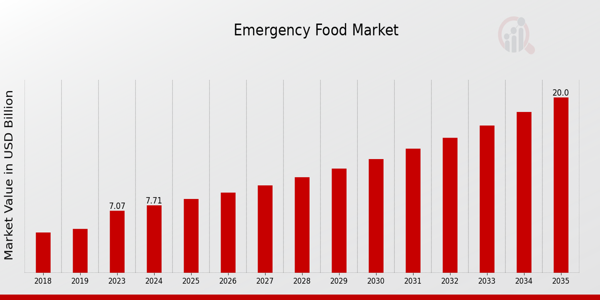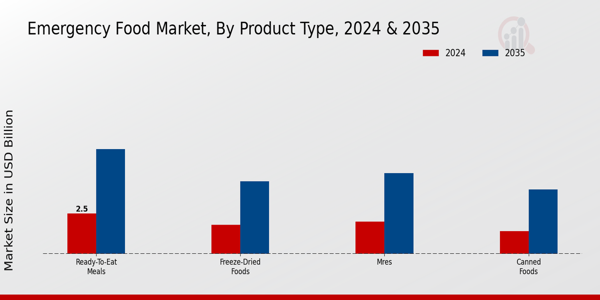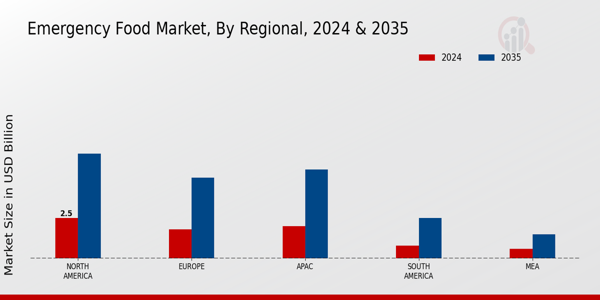Global Emergency Food Market Overview
Emergency Food Market Size was estimated at 7.07 (USD Billion) in 2023.The Emergency Food Market Industry is expected to grow from 7.71(USD Billion) in 2024 to 20.0 (USD Billion) by 2035. The Emergency Food Market CAGR (growth rate) is expected to be around 9.05% during the forecast period (2025 - 2035).

Source: Primary Research, Secondary Research, MRFR Database and Analyst Review
Key Emergency Food Market Trends Highlighted
The Emergency Food Market is experiencing significant changes driven by a series of key factors. The increasing frequency of natural disasters, conflicts, and pandemics has heightened the need for effective emergency food supplies. Additionally, the growing awareness of food security issues and government mandates for preparedness have amplified the demand for reliable emergency food options. The rise in urbanization and population density further complicates food distribution, making accessible emergency food a critical necessity in cities that are prone to disruption. Alongside these drivers, there are numerous opportunities that can be explored in this market.Companies can innovate by developing high-quality, long-shelf-life foods that cater to various dietary needs, including vegetarian, vegan, and gluten-free options. There is also an emerging market for private-label products that provide consumers with more choices at competitive prices. Furthermore, advancements in packaging technology could enhance the appeal and usability of emergency food supplies, making them more convenient for consumers. The integration of e-commerce platforms is another avenue that can be leveraged to ensure the timely delivery of emergency food supplies to individuals, families, and organizations. In recent times, trends within the market indicate a shift towards more sustainable practices.Consumers are becoming increasingly environmentally conscious, leading companies to seek sustainable sourcing and production methods. Ingredient transparency is becoming more important, as individuals want to know what they are consuming, even in emergency situations. The use of technology to improve distribution logistics and inventory management is also gaining traction, further optimizing supply chain efficiencies. Overall, the Emergency Food Market is poised for evolution, driven by changing consumer preferences and the imperative need for preparedness in the face of unforeseen challenges.
Emergency Food Market Drivers
Increasing Natural Disasters and Emergencies
The frequency and intensity of natural disasters, such as hurricanes, floods, and earthquakes, have been escalating globally, driving the demand for emergency food supplies. The Emergency Food Market Industry is seeing significant influence from these changes as governments and organizations seek reliable food sources to aid affected populations. Emergency food is essential for immediate relief efforts in regions experiencing crisis situations.This need for rapid-response food solutions spurs growth in the market as countries aim to improve their disaster preparedness and response strategies. With climate change contributing to more unpredictable weather patterns, the urgency for provisions, including non-perishable food items that can sustain individuals for extended periods, is heightened. This growing need significantly propels investments in the Emergency Food Market, emphasizing the importance of having emergency food stocks that can be deployed to disaster zones quickly.Moreover, the rise in awareness surrounding food security in emergencies encourages governments and NGOs to prioritize the procurement of specialized emergency food items, thereby solidifying market growth prospects throughout the coming decades. Therefore, in order to enhance stakeholder efficiency who are involved in logistics, there is a significant need to come up with more advanced methods for producing and distributing food across locations. Furthermore, developing strategies to mitigate the harms caused by unforeseen disasters will remain a key motivation for the Emergency Food Market Industry, given the expected increase in future market capitalization.
Growing Awareness of Food Security
The awareness surrounding food security has gained momentum, prompting individuals and organizations to understand the necessity of having emergency food supplies on hand. Events like pandemics, political unrest, and economic turmoil have showcased vulnerabilities in global food systems, revealing the need for preparedness in any crisis. This growing consciousness drives innovation and investment in the Emergency Food Market Industry as businesses work to create diverse, nutritionally balanced food offerings that can withstand long shelf lives.As such, methods of production and storage are continuously optimized to meet emerging consumer expectations.
Technological Advancements in Food Preservation
Advancements in food preservation technology, such as freeze-drying and vacuum sealing, are enhancing the quality and shelf life of emergency food products. These technologies not only ensure that food remains safe for consumption during emergencies but also improve the nutritional value and flavor, making them more appealing to consumers. The Emergency Food Market Industry benefits significantly from these innovations, leading to an increase in market acceptance and demand as more people recognize the importance of having accessible, high-quality food supplies in times of need.
Emergency Food Market Segment Insights:
Emergency Food Market Product Type Insights
The Emergency Food Market is segmented into various product types that cater to the growing demand for survival scenarios, disaster relief and emergency preparedness. By 2024, the market is projected to hold a substantial valuation of 7.71 USD Billion, reflecting the increasing awareness around food security and emergency nutrition solutions. Among the various product types, Ready-to-Eat Meals holds a significant share, valued at 2.5 USD Billion in 2024, and is expected to reach 6.5 USD Billion by 2035, indicating its majority holding in the market due to convenience and extended shelf life, making it a preferred option for consumers looking for quick and nutritious meals during emergencies.Freeze-Dried Foods, another critical category, is valued at 1.8 USD Billion in 2024 and anticipated to grow to 4.5 USD Billion by 2035, offering lightweight and long-lasting food alternatives that are ideal for camping, hiking, and emergency kits. MREs, or Meals Ready-to-Eat, stand at 2.0 USD Billion in 2024, and with a growth trajectory towards 5.0 USD Billion by 2035, showcase their significance in military and disaster-response situations where ready nutrition is vital. Canned Foods, although the least dominant in terms of value at 1.41 USD Billion in 2024 are projected to grow to 4.0 USD Billion in 2035, appealing to a broad audience for their availability and affordability.Each of these product types plays an essential role in addressing the needs of consumers for emergency food supplies, driven by market growth fueled by an increase in natural disasters, urbanization and consumer interest in self-sufficiency. The insights gathered from Emergency Food Market statistics validate the critical nature of these food segments in maintaining a prepared populace ready to face unforeseen challenges.

Source: Primary Research, Secondary Research, MRFR Database and Analyst Review
Emergency Food Market Distribution Channel Insights
The Distribution Channel segment of the Emergency Food Market plays a pivotal role in ensuring that consumers have access to essential food supplies, particularly during crises. Within this segment, various channels facilitate the distribution of products to consumers, each contributing uniquely to the market dynamics. Online retail has emerged as a significant player, offering convenience and a wide range of options for customers seeking emergency food supplies.
Supermarkets are also vital, providing easy access for those stocking up on emergency essentials during peak buying periods. Convenience stores cater to consumers looking for quick purchases, often assisting last-minute needs, while Emergency Preparedness Stores specifically target individuals and families preparing for potential disasters, highlighting the growing awareness of emergency readiness. The interplay among these channels illustrates a responsive market structure that adapts to consumer needs, fueling the overall growth of the Emergency Food Market revenue.Insights into this segmentation reveal trends driven by increasing preparedness consciousness and the convenience of accessible resources, encouraging significant shifts in purchasing behaviors and market growth.
Emergency Food Market End User Insights
The Emergency Food Market has been structured around various End Users, which play a crucial role in its expansion and adoption. Individuals and families represent a significant portion of this market, focusing on preparedness for unexpected emergencies and ensuring food security. Military applications for emergency food products dominate due to the essential need for ready-to-eat meals in various operational environments.
Meanwhile, disaster relief organizations also command a substantial share, requiring dependable food supplies to support populations affected by natural disasters or conflicts. The market's growth is further supported by rising awareness around food security and the increasing occurrence of climate-related emergencies, which presents numerous opportunities for providers in the Emergency Food Market industry to expand their offerings and cater to evolving consumer needs, thereby enhancing overall market growth. The Emergency Food Market data reflects a diversification of products aimed at meeting these unique demands from each end user..Emergency Food Market Packaging Type Insights
Packaging type plays a critical role in ensuring the shelf-life, portability and convenience of emergency food supplies. Among these, pouches are notable for their lightweight and resealable features, which enhance ease of use while minimizing bulk. Cans offer durability and long shelf life, making them a staple in emergency food kits. Meanwhile, boxes provide a practical solution for bulk packing, often containing ready-to-eat meals, which are increasingly favored during emergencies.
Bulk packaging is crucial for institutions or larger family needs, allowing for efficient stockpiling. With evolving consumer preferences towards more convenient and environmentally friendly options, the demand for packaging that maintains product integrity while being user-friendly is steadily growing. The diversification within the Emergency Food Market segmentation indicates a response to increasing awareness about preparedness, nutrition, and sustainability, opening various opportunities for innovation and growth in packaging solutions.As the market evolves, understanding these packaging dynamics will be essential for stakeholders looking to capitalize on emerging trends and consumer demands.
Emergency Food Market Regional Insights
North America leads the landscape, holding a valuation of 2.5 USD Billion in 2024, and is anticipated to expand significantly to 6.5 USD Billion by 2035, demonstrating its dominance as a key player in this market. Europe follows with a valuation of 1.8 USD Billion in 2024, expected to rise to 5.0 USD Billion by 2035, reflecting its significant role in emergency food solutions. The APAC region, valued at 2.0 USD Billion in 2024 and projected to grow to 5.5 USD Billion, showcases a burgeoning demand driven by population growth and increasing disaster preparedness measures.
South America and MEA, with valuations of 0.8 USD Billion and 0.61 USD Billion, respectively, in 2024, represent the emerging markets with potential for growth in the emergency food sector, although they currently hold smaller shares, accounting for fewer resources compared to the larger regions. As the industry evolves, the regional insights reveal a dynamic landscape shaped by local needs and preparedness strategies, driving the overall growth within the Emergency Food Market industry.

Source: Primary Research, Secondary Research, MRFR Database and Analyst Review
Emergency Food Market Key Players and Competitive Insights:
The Emergency Food Market has gained significant traction as a consequence of increasing natural disasters, geopolitical unrest, and public health emergencies, all of which necessitate the availability of emergency food supplies. This market is characterized by a wide array of products ranging from ready-to-eat meals to food rations designed to meet the diverse nutritional needs of different populations in crisis situations. As competition intensifies, companies within this sector are continually innovating their offerings to include longer shelf-life products, enhanced nutrient profiles, and packaging solutions for easy transport and storage. Additionally, the market is segmented based on distribution channels and geographical presence, each contributing to the unique strategies adopted by market players to gain a competitive edge.Kraft Heinz holds a strong position within the Emergency Food Market, capitalizing on its extensive portfolio of food products designed for emergency preparedness. The company's reputation for quality and reliability enhances its appeal to consumers and agencies involved in disaster response. Kraft Heinz leverages its established supply chain networks to ensure timely delivery and distribution of its emergency food products, which is a critical aspect in times of crisis. The production capabilities and innovations, such as freeze-dried meals and vacuum-sealed packaging, have strengthened Kraft Heinz’s product offerings, catering to the increasing demand for convenient, nutritious meals that require minimal preparation. Furthermore, the company’s commitment to sustainability and responsible sourcing has positioned it favorably among consumers who prioritize environmentally friendly practices.Nestle also commands a notable presence in the Emergency Food Market, recognized for its well-researched and high-quality food solutions designed for emergencies. The brand benefits from its extensive experience in the food industry, allowing it to develop products that not only meet nutritional standards but also align with consumer preferences for taste and convenience. Nestle's investment in research and development enables the continuous improvement and innovation of its emergency food products, ensuring they remain relevant in a rapidly changing market. The company’s global reach and established distribution channels facilitate easy access to its offerings in various regions, responding effectively to disasters and humanitarian needs. Additionally, Nestle's emphasis on collaboration with governmental and non-governmental organizations enhances its credibility and presence in the emergency food sector, making it a trusted partner during crisis situations.
Key Companies in the Emergency Food Market Include:
-
Kraft Heinz
-
Nestle
-
Pilgrim's Pride
-
International Child Care
-
Unilever
-
Cargill
-
Conagra Brands
-
General Mills
-
PepsiCo
-
Bunge Limited
-
James Farming Co.
-
Tyson Foods
-
Danone
-
Hormel Foods
-
Food Aid International
Emergency Food Market Industry Developments
Recent developments in the Emergency Food Market highlight a significant rise in consumer demand for food security solutions amid climate change impacts and geopolitical tensions. Companies such as Kraft Heinz and Nestle are emphasizing innovation in their product lines to address nutritional inadequacies, particularly in areas affected by crises. Concurrently, firms like Unilever and Cargill are expanding their sustainable sourcing practices, enhancing their global supply chains to ensure accessibility in emergency situations.
Notably, there have been acquisitions that strengthen market presence, with Tyson Foods making strategic moves to enhance its portfolio, while General Mills remains active in forging partnerships to build emergency response capabilities. Furthermore, the valuation of companies like PepsiCo and Danone has experienced growth due to an increased focus on sustainable food production practices, positively influencing their market position. In the wake of ongoing global feeding challenges, organizations, including Food Aid International, are collaborating with major players like Conagra Brands and Hormel Foods to implement distribution networks for emergency food supplies, thereby responding to an urgent need for resilience in food security.
Emergency Food Market Segmentation Insights
-
Emergency Food Market Distribution Channel Outlook
-
Emergency Food Market End User Outlook
-
Emergency Food Market Packaging Type Outlook
-
Pouches
-
Cans
-
Boxes
-
Bulk Packaging
-
Emergency Food Market Regional Outlook
-
North America
-
Europe
-
South America
-
Asia Pacific
-
Middle East and Africa
| Report Attribute/Metric |
Details |
| Market Size 2023 |
7.07(USD Billion) |
| Market Size 2024 |
7.71(USD Billion) |
| Market Size 2035 |
20.0(USD Billion) |
| Compound Annual Growth Rate (CAGR) |
9.05% (2025 - 2035) |
| Report Coverage |
Revenue Forecast, Competitive Landscape, Growth Factors, and Trends |
| Base Year |
2024 |
| Market Forecast Period |
2025 - 2035 |
| Historical Data |
2019 - 2024 |
| Market Forecast Units |
USD Billion |
| Key Companies Profiled |
Kraft Heinz, Nestle, Pilgrim's Pride, International Child Care, Unilever, Cargill, Conagra Brands, General Mills, PepsiCo, Bunge Limited, James Farming Co., Tyson Foods, Danone, Hormel Foods, Food Aid International |
| Segments Covered |
Product Type, Distribution Channel, End User, Packaging Type, Regional |
| Key Market Opportunities |
Rising climate-related disaster preparedness, Increasing demand for portable nutrition, Growth in online emergency food sales, Enhanced product shelf-life innovation, Expansion into developing markets |
| Key Market Dynamics |
rising natural disasters, increasing food insecurity, government aid initiatives, growing awareness of preparedness, advancements in food preservation |
| Countries Covered |
North America, Europe, APAC, South America, MEA |
Frequently Asked Questions (FAQ) :
The Emergency Food Market was projected to be valued at 7.71 billion USD in 2024.
By 2035, the Emergency Food Market is expected to reach a value of 20.0 billion USD.
The expected CAGR for the Emergency Food Market from 2025 to 2035 is 9.05%.
Ready-to-Eat Meals are expected to lead the Emergency Food Market with a valuation of 2.5 billion USD in 2024.
Freeze-Dried Foods are projected to have a market value of 4.5 billion USD in 2035.
North America will hold the largest market share, valued at 2.5 billion USD in 2024.
Canned Foods are expected to reach a market size of 4.0 billion USD in 2035.
Major players in the Emergency Food Market include Kraft Heinz, Nestle and Unilever, among others.
Europe's market is projected to grow, reaching a value of 5.0 billion USD by 2035, starting from 1.8 billion USD in 2024.
The Emergency Food Market may face challenges related to supply chain disruptions and changing consumer preferences.

















